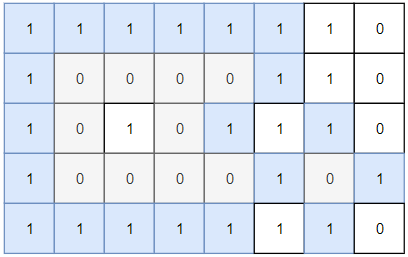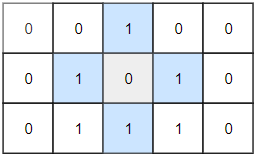★★★★★★★★★★★★★★★★★★★★★★★★★★★★★★★★★★★★★★★★
➤微信公众号:山青咏芝(let_us_code)
➤博主域名:https://www.zengqiang.org
➤GitHub地址:https://github.com/strengthen/LeetCode
➤原文地址:https://www.cnblogs.com/strengthen/p/11831493.html
➤如果链接不是山青咏芝的博客园地址,则可能是爬取作者的文章。
➤原文已修改更新!强烈建议点击原文地址阅读!支持作者!支持原创!
★★★★★★★★★★★★★★★★★★★★★★★★★★★★★★★★★★★★★★★★
Given a 2D grid consists of 0s (land) and 1s (water). An island is a maximal 4-directionally connected group of 0s and a closed island is an island totally (all left, top, right, bottom) surrounded by 1s.
Return the number of closed islands.
Example 1:

Input: grid = [[1,1,1,1,1,1,1,0],[1,0,0,0,0,1,1,0],[1,0,1,0,1,1,1,0],[1,0,0,0,0,1,0,1],[1,1,1,1,1,1,1,0]] Output: 2 Explanation: Islands in gray are closed because they are completely surrounded by water (group of 1s).
Example 2:

Input: grid = [[0,0,1,0,0],[0,1,0,1,0],[0,1,1,1,0]] Output: 1
Example 3:
Input: grid = [[1,1,1,1,1,1,1],
[1,0,0,0,0,0,1],
[1,0,1,1,1,0,1],
[1,0,1,0,1,0,1],
[1,0,1,1,1,0,1],
[1,0,0,0,0,0,1],
[1,1,1,1,1,1,1]]
Output: 2
Constraints:
1 <= grid.length, grid[0].length <= 1000 <= grid[i][j] <=1
有一个二维矩阵 grid ,每个位置要么是陆地(记号为 0 )要么是水域(记号为 1 )。
我们从一块陆地出发,每次可以往上下左右 4 个方向相邻区域走,能走到的所有陆地区域,我们将其称为一座「岛屿」。
如果一座岛屿 完全 由水域包围,即陆地边缘上下左右所有相邻区域都是水域,那么我们将其称为 「封闭岛屿」。
请返回封闭岛屿的数目。
示例 1:

输入:grid = [[1,1,1,1,1,1,1,0],[1,0,0,0,0,1,1,0],[1,0,1,0,1,1,1,0],[1,0,0,0,0,1,0,1],[1,1,1,1,1,1,1,0]] 输出:2 解释: 灰色区域的岛屿是封闭岛屿,因为这座岛屿完全被水域包围(即被 1 区域包围)。
示例 2:

输入:grid = [[0,0,1,0,0],[0,1,0,1,0],[0,1,1,1,0]] 输出:1
示例 3:
输入:grid = [[1,1,1,1,1,1,1],
[1,0,0,0,0,0,1],
[1,0,1,1,1,0,1],
[1,0,1,0,1,0,1],
[1,0,1,1,1,0,1],
[1,0,0,0,0,0,1],
[1,1,1,1,1,1,1]]
输出:2
提示:
1 <= grid.length, grid[0].length <= 1000 <= grid[i][j] <=1
1 class Solution { 2 func closedIsland(_ grid: [[Int]]) -> Int { 3 var grid = grid 4 for i in 0..<grid.count 5 { 6 for j in 0..<grid[i].count 7 { 8 if i == 0 || j == 0 || i == grid.count - 1 || j == grid[i].count - 1 9 { 10 fill(&grid, i, j) 11 } 12 } 13 } 14 var res:Int = 0 15 for i in 0..<grid.count 16 { 17 for j in 0..<grid[i].count 18 { 19 res += fill(&grid, i, j) > 0 ? 1 : 0 20 } 21 } 22 return res 23 } 24 25 func fill(_ g: inout [[Int]],_ i:Int,_ j:Int) -> Int 26 { 27 if i < 0 || j < 0 || i >= g.count || j >= g[i].count || g[i][j] != 0 28 { 29 return 0 30 } 31 g[i][j] = 1 32 return g[i][j] + fill(&g, i + 1, j) + fill(&g, i, j + 1) + fill(&g, i - 1, j) + fill(&g, i, j - 1) 33 } 34 }